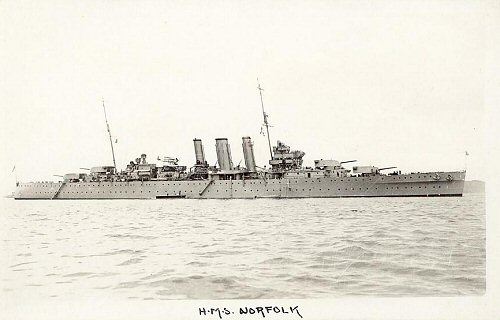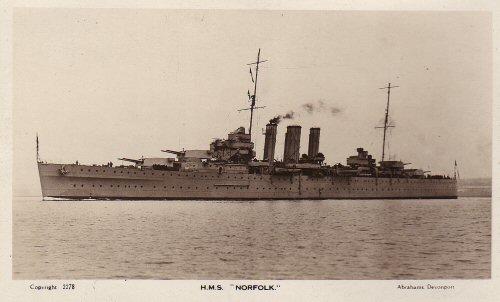
Broken up. 14 November 1950
HMS Norfolk was built by Fairfield,launched 12/12/1928.Arrived at Newport for breaking up,19/2/1950.
In September 1931, HMS Norfolk was part of a mutiny that later became known as the Invergordon Mutiny. She later served with the Home Fleet until she re-commissioned for service in the East Indies Station in 1937.
At the outbreak of war in 1939, Norfolk deployed with the Home Fleet, and was involved in the chase for the German battlecruisers (or light battleships) Gneisenau and Scharnhorst, along with the Admiral Scheer. She was soon receiving numerous repairs for damage that she had received, not to mention vital modifications to the ship. Her first repairs were carried out in Belfast, after a near-miss by a torpedo from the German submarine U-47, the submarine responsible for sinking the Royal Navy battleship Royal Oak.
Shortly afterwards, bomb damage that she had received from a heavy air raid, forced her into yet another repair, this time on the Clyde. After these repairs had been completed, Norfolk proceeded to the Tyne Shipyard for a new addition to her equipment - a radar set.
In May 1941, Norfolk was the second ship to sight the Bismarck. She continued to dog the German battleship and was part of the force with Rodney and King George V that sank her. From September onwards, she was employed as an escort for the arduous Arctic Convoys. Norfolk was part of the cruiser covering force of convoy JW55B, when it engaged Scharnhorst, on 26 December 1943. She scored three hits on the German vessel which withdrew and was later caught and sunk by the Duke of York and her escorts.
She sustained damage in that confrontation, which was subsequently repaired on the Tyne, which prevented her from being involved in the historic D-day landings. When the war came to a close, Norfolk left Plymouth for a much needed refit at Malta, after transporting the Norwegian Royal family back to Oslo after their 5-year exile in London. This was followed by service in the East Indies as the flagship of the Commander-In-Chief East Indies Station.
In 1949, Norfolk returned to the UK and was placed in Reserve. On 14 February 1950, she proceeded to Newport to be broken up after a long and proud service of 22 years, in which she gained the Norfolk lineage the majority of its battle honours, including its last.
